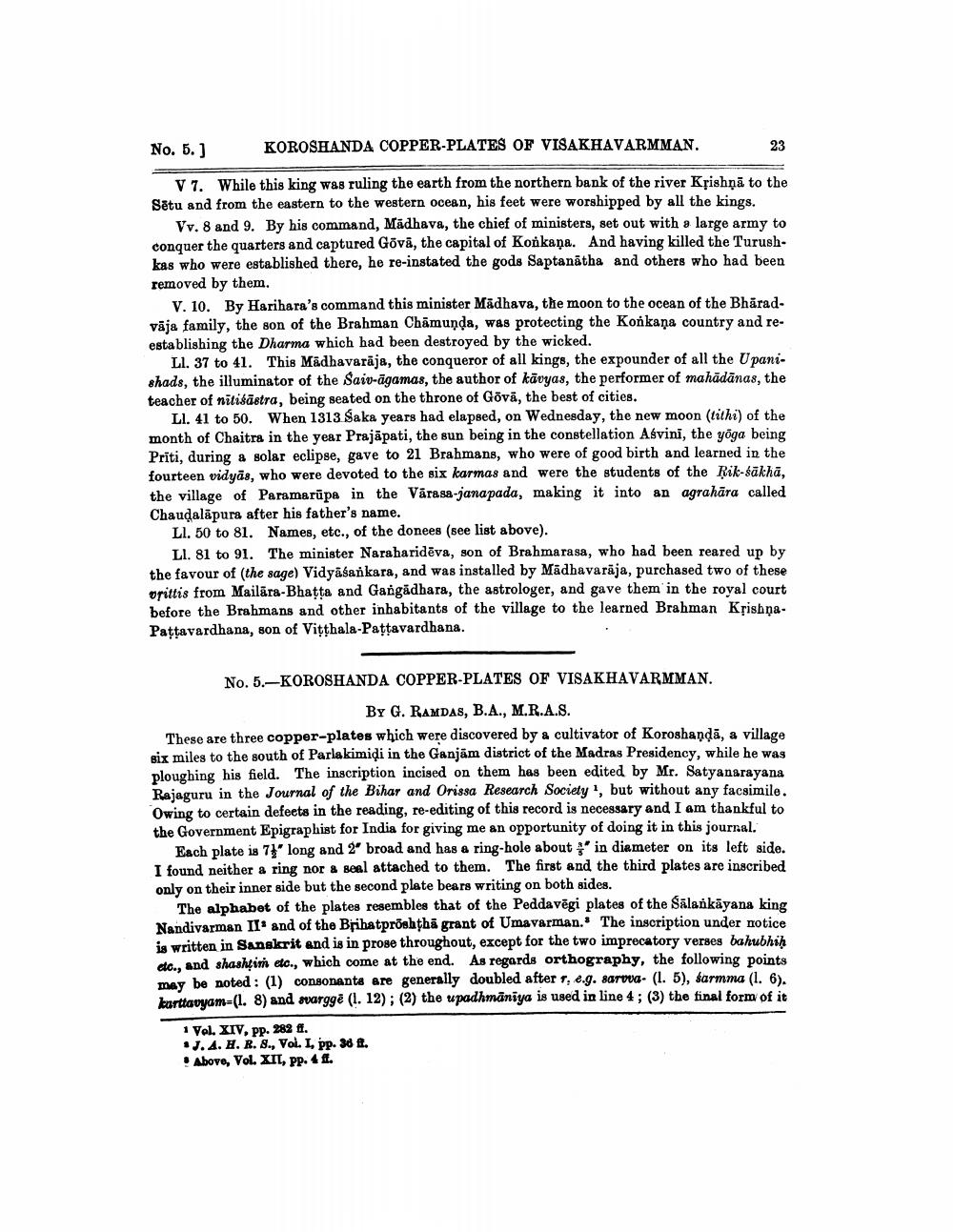________________
No. 5.)
KOROSHANDA COPPER-PLATES OF VISAKHAVARMMAN.
23
V 7. While this king was ruling the earth from the northern bank of the river Kțishņā to the Sētu and from the eastern to the western ocean, his feet were worshipped by all the kings.
Vv. 8 and 9. By his command, Madhava, the chief of ministers, set out with a large army to conquer the quarters and captured Gövā, the capital of Konkaņa. And having killed the Turushkas who were established there, he re-instated the gods Saptanātha and others who had been removed by them.
V. 10. By Harihara's command this minister Mädhava, the moon to the ocean of the Bhärad. vāja family, the son of the Brahman Chamunda, was protecting the Konkaņa country and reestablishing the Dharma which had been destroyed by the wicked.
Ll. 37 to 41. This Mädhavarāja, the conqueror of all kings, the expounder of all the Upanishads, the illuminator of the Saiv-āgamas, the author of kavyas, the performer of mahādānas, the teacher of nitiśāstra, being seated on the throne of Gövā, the best of cities.
Ll. 41 to 50. When 1313 Saka years had elapsed, on Wednesday, the new moon (tithi) of the month of Chaitra in the year Prajāpati, the sun being in the constellation Asvini, the yoga being Priti, during & solar eclipse, gave to 21 Brahmans, who were of good birth and learned in the fourteen vidyās, who were devoted to the six karmas and were the students of the Rik-sakha, the village of Paramarüpa in the Värasa-janapada, making it into an agrahāra called Chaudaläpura after his father's name.
Ll. 50 to 81. Names, etc., of the donees (see list above).
Ll. 81 to 91. The minister Naraharidēva, son of Brahmarasa, who had been reared up by the favour of the sage) Vidyāšankara, and was installed by Madhavarāja, purchased two of these orittis from Mailāra-Bhatta and Gangadhara, the astrologer, and gave them in the royal court before the Brahmans and other inhabitants of the village to the learned Brahman KrishnaPattavardhana, son of Vitthala-Pattavardhana.
No. 5.-KOROSHANDA COPPER-PLATES OF VISAKHAVARMMAN.
By G. RAMDAS, B.A., M.R.A.S. These are three copper-plates which were discovered by a cultivator of Koroshandā, a village six miles to the south of Parlakimidi in the Ganjām district of the Madras Presidency, while he was ploughing his field. The inscription incised on them has been edited by Mr. Satyanarayana Rajaguru in the Journal of the Bihar and Orissa Research Society, but without any facsimile. Owing to certain defeets in the reading, re-editing of this record is necessary and I am thankful to the Government Epigraphist for India for giving me an opportunity of doing it in this journal.
Each plate is 7" long and 2 broad and has a ring-hole about " in diameter on its left side. I found neither a ring nor & seal attached to them. The first and the third plates are inscribed only on their inner side but the second plate bears writing on both sides.
The alphabet of the plates resembles that of the Peddavēgi plates of the Salankāyana king Nandivarman II* and of the Brihatproshtha grant of Umavarman. The inscription under notice is written in Sanskrit and is in prose throughout, except for the two imprecatory verses bahubhih etc., and shashtin elo., which come at the end. As regards orthography, the following points may be noted : (1) consonants are generally doubled after f. e.g. sarva- (1. 5), farmma (1. 6). kartta yam=(1. 8) and svargge (l. 12); (2) the upadhmāniya is used in line 4; (3) the final form of it
1 Vel. XIV, PP. 282 ff.
J.A. H. R. 8., Vol. I, pp. 38 t. Above, Vol. XIL, PP. 4 f.




